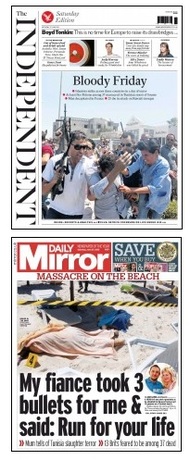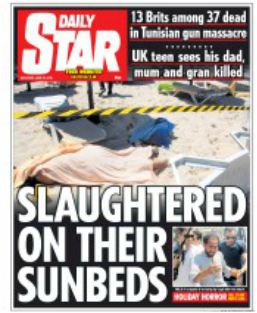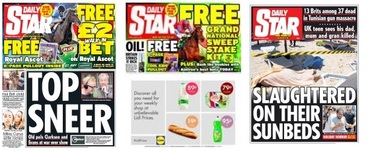Hats off to the Daily Star for getting it exactly right with this morning's coverage of the terrorist attack in Tunisia.
It's been a long time since one story dominated every front page, so SubScribe has risen from its summer slumbers to take a look.
It was an instructive exercise because today's front pages tell us a lot about the mindsets and conventions that prevail - often subconsciously - in tackling stories like this.
The main point, of course, is that the killings took place on a tourist beach popular with Europeans, a new target area for Isis (although Israeli resorts have been attacked in the past). With the start of a promised mini-heatwave at home, it is much easier to relate to families relaxing on sun loungers or playing in the sand than it would be on a rainy April afternoon.
Another key element is that the victims were shot - a far more "personal" form of murder than bombing.
These were enough to make the story the splash in most papers. The clincher for the rest was the fact that the victims included British tourists - and the availability of British witnesses to tell their stories. When the papers went to press last night, most were saying that there were five Britons among the thirty-seven dead. We know today that the figure is likely to be much higher.
It's been a long time since one story dominated every front page, so SubScribe has risen from its summer slumbers to take a look.
It was an instructive exercise because today's front pages tell us a lot about the mindsets and conventions that prevail - often subconsciously - in tackling stories like this.
The main point, of course, is that the killings took place on a tourist beach popular with Europeans, a new target area for Isis (although Israeli resorts have been attacked in the past). With the start of a promised mini-heatwave at home, it is much easier to relate to families relaxing on sun loungers or playing in the sand than it would be on a rainy April afternoon.
Another key element is that the victims were shot - a far more "personal" form of murder than bombing.
These were enough to make the story the splash in most papers. The clincher for the rest was the fact that the victims included British tourists - and the availability of British witnesses to tell their stories. When the papers went to press last night, most were saying that there were five Britons among the thirty-seven dead. We know today that the figure is likely to be much higher.
The marketing people will have been relieved that the final British death toll had yet to emerge. It sounds cynical, but five dead Britons are not enough to drive the puffs from their home at the top of the front. Especially on a Saturday morning, when the promos are deeper and occupy extra columns in the body of the page. Ten might have been; "at least fifteen" - the figure announced by Phil Hammond this afternoon - certainly would.
This is why the Star shines today. Look at last Saturday's front page, look at the one lampooned on this blog in April and look at today's. Hallelujah! News has reclaimed page one. And not only page one, but pages two, three, four and five.
This is why the Star shines today. Look at last Saturday's front page, look at the one lampooned on this blog in April and look at today's. Hallelujah! News has reclaimed page one. And not only page one, but pages two, three, four and five.

The Mirror restricted its puff to a little box beside the titlepiece, the Sun to a single column; the Telegraph and Times abandoned the secondary elements in the outside columns, but only the Star cleared the page in recognition not only of what the story was yesterday (it took a gamble in putting the number of British dead at 13) but of what it would likely turn out to be over the weekend.
Hindsight is a wonderful thing, but how many will be wishing today that they had taken the same approach? How does that giant Eat! or the offer of £5 off at Lidl sit with the "slaughter" headings? And even worse, a £15 UK holiday promotion with its - hopefully unintentional - subliminal message "Don't risk your life going abroad"? A closer examination of these pages in the round wouldn't have gone amiss.
Worst of all in this context was the Guardian where the story was sandwiched between a garish puff and a sponsored house ad. Was Kath Viner happy with this? Did she sign it off? Would this have happened under the more experienced eye of Alan Rusbridger? That may be an unfair question, but it's one that Viner should be asking herself in these early days of her editorship.
And so to the purely editorial aspects of the story: first, the choice of picture.
SubScribe takes the old-school view of publishing photographs of the dead - basically, don't - but accepts that different standards apply today, especially where the bodies are covered.
Hindsight is a wonderful thing, but how many will be wishing today that they had taken the same approach? How does that giant Eat! or the offer of £5 off at Lidl sit with the "slaughter" headings? And even worse, a £15 UK holiday promotion with its - hopefully unintentional - subliminal message "Don't risk your life going abroad"? A closer examination of these pages in the round wouldn't have gone amiss.
Worst of all in this context was the Guardian where the story was sandwiched between a garish puff and a sponsored house ad. Was Kath Viner happy with this? Did she sign it off? Would this have happened under the more experienced eye of Alan Rusbridger? That may be an unfair question, but it's one that Viner should be asking herself in these early days of her editorship.
And so to the purely editorial aspects of the story: first, the choice of picture.
SubScribe takes the old-school view of publishing photographs of the dead - basically, don't - but accepts that different standards apply today, especially where the bodies are covered.
The presence of the sunbed in the picture of the couple used by the Star, Mirror and Times brings home the full circumstances of the murder, but I don't like the fact that the woman's feet are exposed.
The Sun used a picture of the same couple taken from a different angle, the Mail and i had a man standing over another body with a gawping crowd in the background; the Express and Independent opted for the killer being arrested; the Telegraph and Guardian chose a photograph of a victim being stretchered off the beach.
The latter conveyed the sense of place and drama, but you could argue that the person on the stretcher could have been pulled out of the water in a solitary drowning accident. Similarly, the arrest photograph could have been taken anywhere.
There's no perfect answer, but the Star seems to have done the best by overlaying the splash head on the picture of the bodies (helpfully obscuring the card that reduces the woman to a number), and using the arrest picture separately alongside the text.
The Sun used a picture of the same couple taken from a different angle, the Mail and i had a man standing over another body with a gawping crowd in the background; the Express and Independent opted for the killer being arrested; the Telegraph and Guardian chose a photograph of a victim being stretchered off the beach.
The latter conveyed the sense of place and drama, but you could argue that the person on the stretcher could have been pulled out of the water in a solitary drowning accident. Similarly, the arrest photograph could have been taken anywhere.
There's no perfect answer, but the Star seems to have done the best by overlaying the splash head on the picture of the bodies (helpfully obscuring the card that reduces the woman to a number), and using the arrest picture separately alongside the text.

On to the headings. It's funny how the slightest difference in wording makes the world of difference in impact . The Star's "Slaughtered on their sunbeds" was spot on. The Mail's "Slaughter on sunbeds" jarred, creating weird mental images of killers riding in on sunbeds, or of the loungers rather than people coming under attack.
The Times, Guardian, i and Express showed that you can't go wrong by telling it straight. The Telegraph and Independent showed that they hadn't grasped the central point of the story with "Laughing as he fired" and "Bloody Friday".
The Independent fell into this trap because it linked the Tunisian attack with a suicide bombing in Kuwait and the beheading of a factory manager in France. They may well be connected, but the combination of that heading and the arrest photograph resulted in a front page that could have applied to any Middle Eastern atrocity on any day this century.
The Mirror went for a dramatic quote from a survivor who had been shielded from the gunman by her fiancé. This is a legitimate approach: a great human tale that takes the story on, given that most readers will have heard about the killings. And, just in case they haven't, there's a "Massacre on the beach" strapline in red above the picture - though it gets a bit lost under the titlepiece and puff.
The Times, Guardian, i and Express showed that you can't go wrong by telling it straight. The Telegraph and Independent showed that they hadn't grasped the central point of the story with "Laughing as he fired" and "Bloody Friday".
The Independent fell into this trap because it linked the Tunisian attack with a suicide bombing in Kuwait and the beheading of a factory manager in France. They may well be connected, but the combination of that heading and the arrest photograph resulted in a front page that could have applied to any Middle Eastern atrocity on any day this century.
The Mirror went for a dramatic quote from a survivor who had been shielded from the gunman by her fiancé. This is a legitimate approach: a great human tale that takes the story on, given that most readers will have heard about the killings. And, just in case they haven't, there's a "Massacre on the beach" strapline in red above the picture - though it gets a bit lost under the titlepiece and puff.

The Sun, meanwhile, went off on its own with an exclusive about how it had foiled a plot to strike at the Armed Forces Day parade in London today. The paper says that its investigations team had infiltrated extremists working on social networks and had been contacted at the beginning of this month by an Isis leader. He had, the paper reports, sent instructions on how to make a backpack bomb and issued orders for the "volunteer" to make a martyrdom video before detonating the device during the parade.
The Sun says that it handed all the information to Scotland Yard, which "praised" the paper. Oddly, the exact terms of this praise are not reported, but a spokesman is quoted as saying: "We'd like to reassure the public that we constantly review security plans for public events", while another says: "The public are encouraged to take part in events as normal."
The Mail is also torn: it splashes on the massacre, but one senses an understandable reluctance to surrender its story about Greville Janner, which sits in column six and then takes precedence over the killings inside, where three spreads start on page 6.
The Sun says that it handed all the information to Scotland Yard, which "praised" the paper. Oddly, the exact terms of this praise are not reported, but a spokesman is quoted as saying: "We'd like to reassure the public that we constantly review security plans for public events", while another says: "The public are encouraged to take part in events as normal."
The Mail is also torn: it splashes on the massacre, but one senses an understandable reluctance to surrender its story about Greville Janner, which sits in column six and then takes precedence over the killings inside, where three spreads start on page 6.
What next?
There's an art in getting the flow of a paper right. A big chunk of heavy news needs something lighter to follow, but not so light that it looks disrespectful or flippant - or simply out of place. Hitting the right note is particularly important after a story that runs over more than one spread as you don't want to jolt the reader who isn't sure on turning the page whether to expect more of the same or something new.
The Guardian's choice of Glastonbury picture, above, and the Sun's bikini beauty, below, were examples of how easy it is to slip on this banana skin.
There's an art in getting the flow of a paper right. A big chunk of heavy news needs something lighter to follow, but not so light that it looks disrespectful or flippant - or simply out of place. Hitting the right note is particularly important after a story that runs over more than one spread as you don't want to jolt the reader who isn't sure on turning the page whether to expect more of the same or something new.
The Guardian's choice of Glastonbury picture, above, and the Sun's bikini beauty, below, were examples of how easy it is to slip on this banana skin.
The Star almost came a cropper at this last hurdle with its heatwave story after two good terror spreads, but just about got away with it.
Let's hope its readers appreciate the switch from testicle-munching jellyfish. Journalism certainly does.
Let's hope its readers appreciate the switch from testicle-munching jellyfish. Journalism certainly does.







 RSS Feed
RSS Feed


